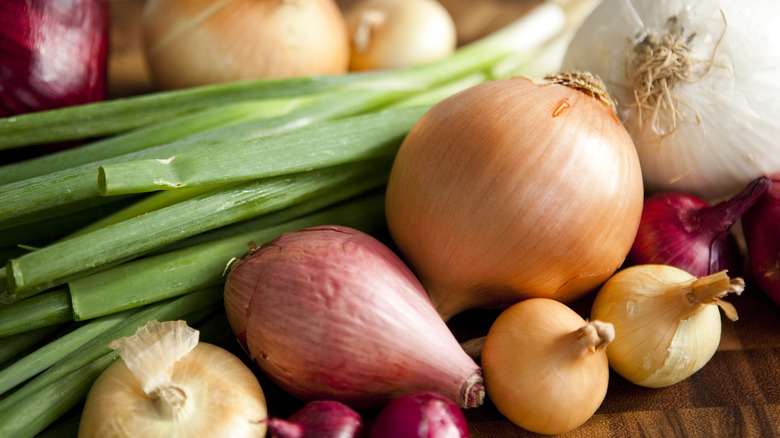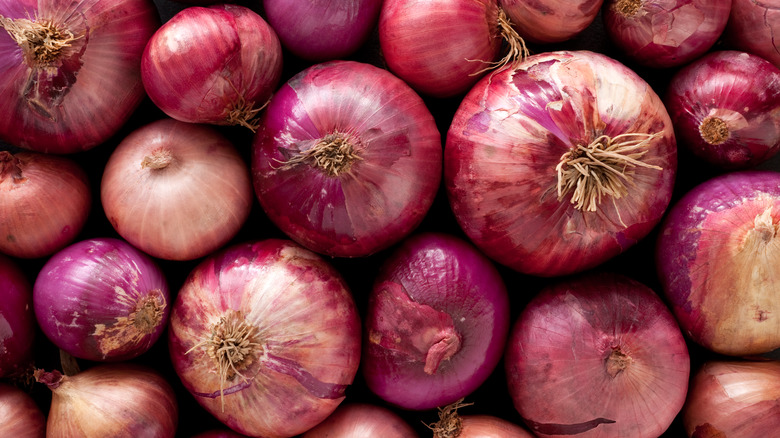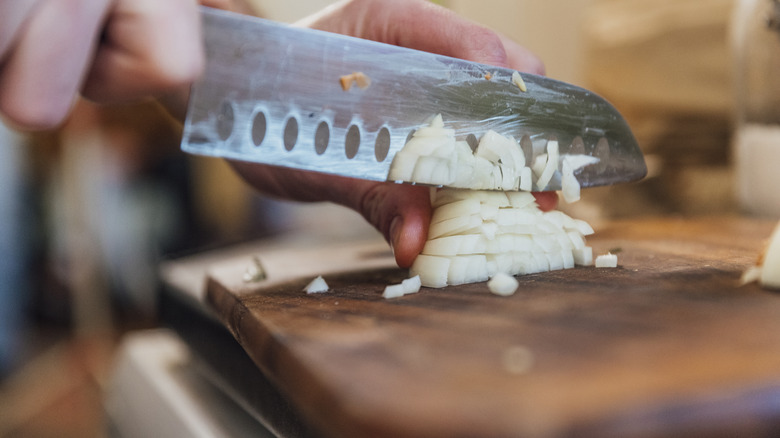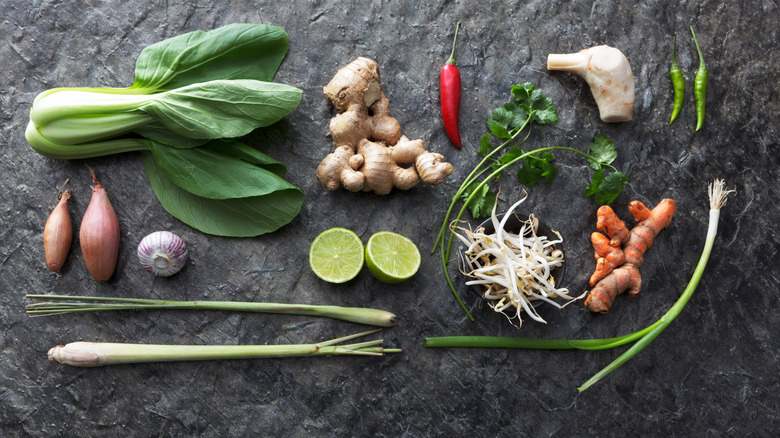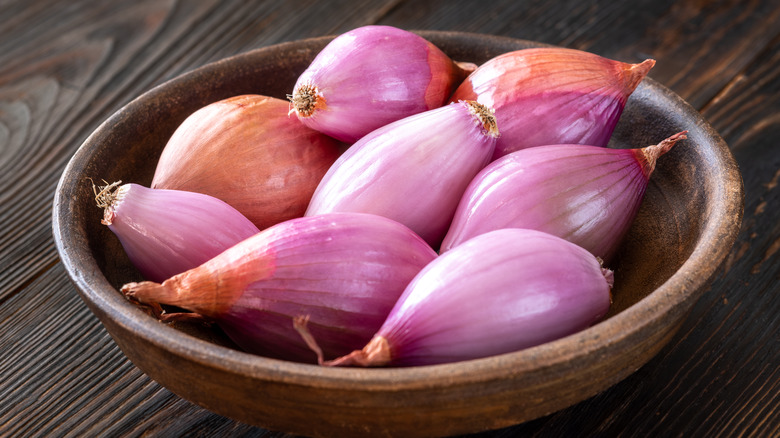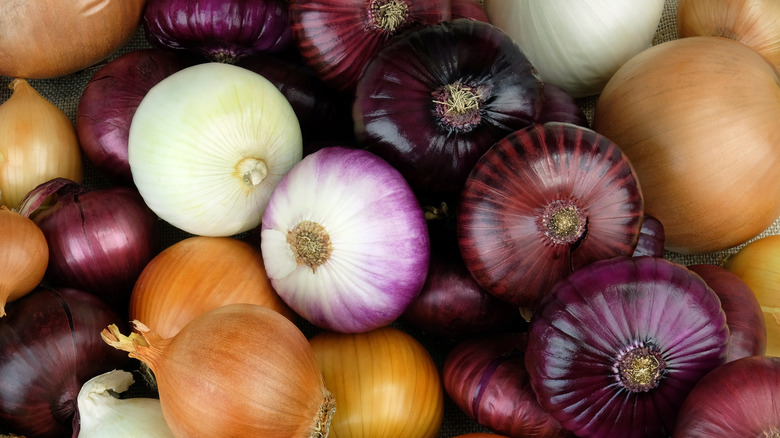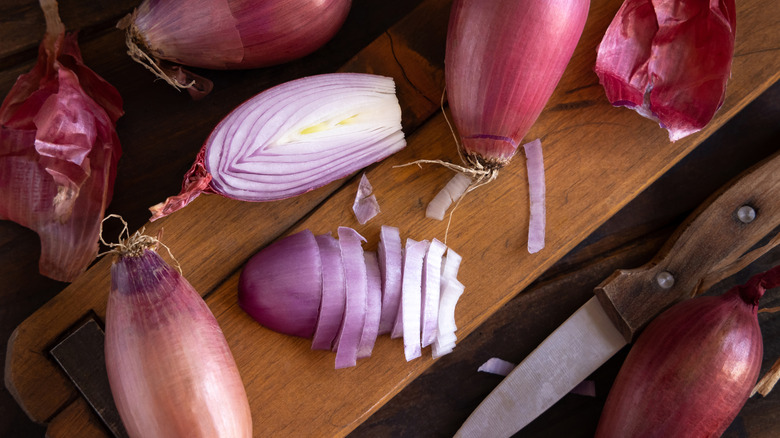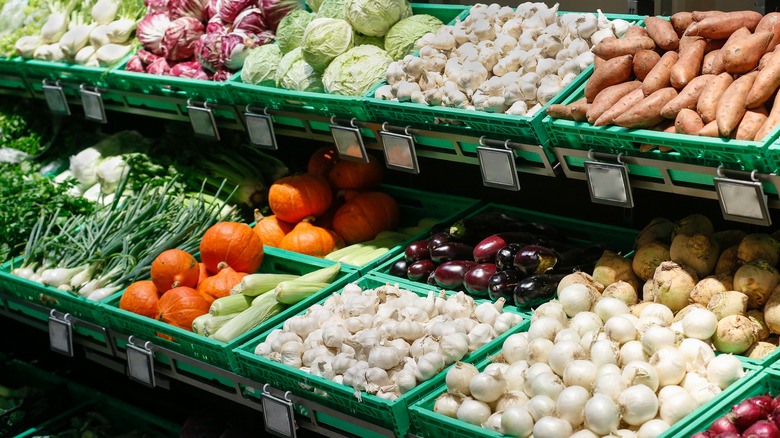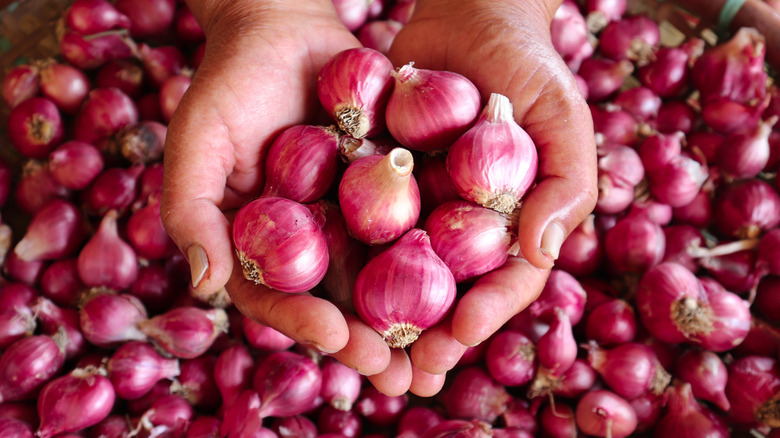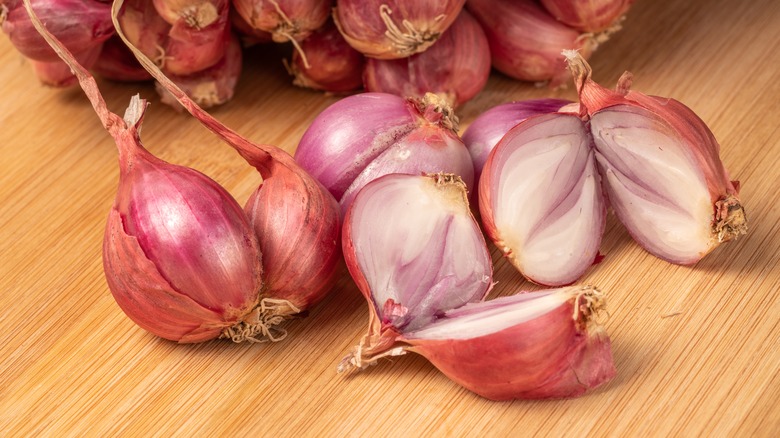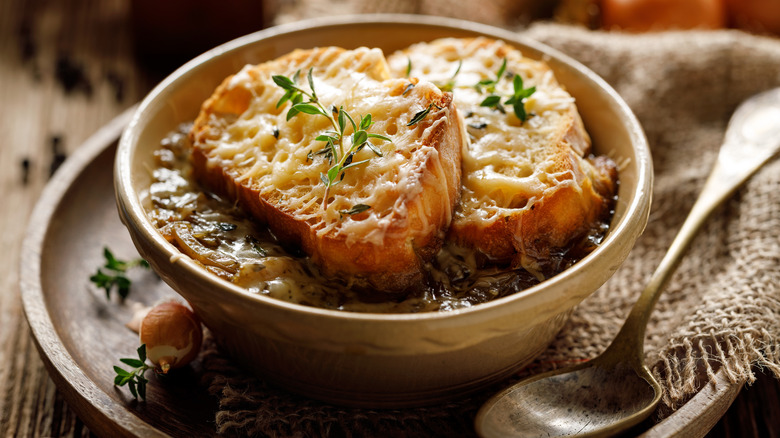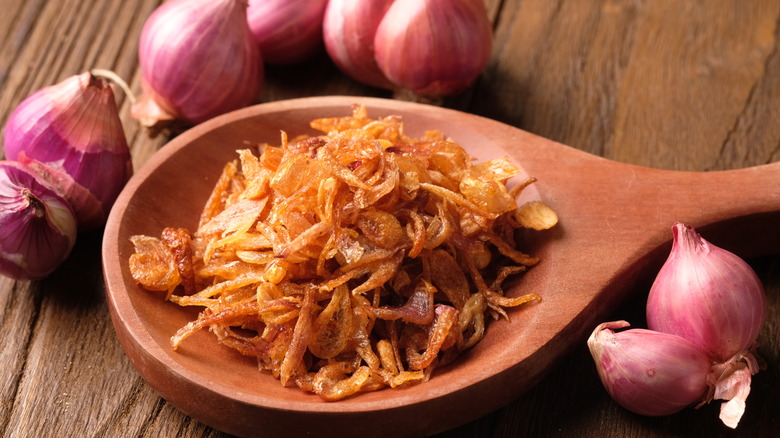Onions Vs Shallots: Everything You Need To Know
It's obvious that onions and shallots have a lot in common. Like garlic, chives and scallions, they both come from the Allium genus and share a distinct sharp, savory flavor that serves as the foundation for countless popular dishes. Besides taste, onions and shallots have a lot of physical traits that overlap, like their papery skin, bulbous shape, and moist, crunchy insides.
Since these two vegetables are so similar, you might wonder what the differences between them actually are. Especially considering the fact that shallots and onions can be used interchangeably for most dishes. But when you actually know what sets shallots and onions apart, you can use these nuances to your advantage, which will elevate your cooking and give you more confidence in the kitchen. To help you along your culinary journey, here's exactly what you need to know about onions and shallots, how their characteristics and applications can differ, and why it's important.
What is an onion?
In terms of popularity, onions are the clear winner. You'd be hard pressed to go into a grocery store and not see at least one type of onion being sold. These well-known veggies are grown worldwide, and are an essential ingredient in a ton of recipes. They're extremely versatile and can be prepared in several ways; they can be fried, sautéed, grilled, boiled, and even eaten raw. Onions can even be eaten before they're fully grown –- this immature form is known as a scallion and is a popular ingredient that's available at most grocery stores.
It is believed that onions were cultivated all the way back in prehistoric times since they're so easy to grow, have a long shelf life and could keep humans adequately hydrated when water was scarce. As for the exact location where onions originated, it's hard to pinpoint, and is thought to have come from central Asia or Iran and West Pakistan.
What is a shallot?
Shallots are basically like the onions' cooler older sibling. While they're not as well-known or widely used, they're favored by chefs due to their unique flavor profile. They generally have a more subtle flavor compared to onions and yet impart a slight garlic-y taste that can amplify a dish when used properly. Typically, shallots are commonly used in salad dressings and sauces — but the real magic happens when they're cooked. The cooking process allows the notes of sweetness to really shine through, and it takes on a deliciously rich caramel flavor. Shallots are more fine than onions, though, and thus break down more easily while cooking.
Like onions, shallots come in different varieties, with the most common being Jersey shallots and French Grey shallots. These veggies were originally founded in a Palestinian port now known as Ashkelon in Israel by ancient Greeks, but today shallots are commonly associated with French cuisine and are used in classic regional recipes like Béarnaise. Shallots can also be found in a number of Asian dishes.
Onions have more intense flavor
One of the most evident differences between the onion and the shallot is taste. Across all of the varieties, onions are considered to be more pungent and have a stronger allium flavor when compared to shallots. Because of this, onions are cooked in many of the recipes they're featured in. When onions are served raw, they can potentially overpower the flavor of the dish, especially when using the wrong kind.
It's true that different types of onions will carry slightly unique flavors, with white onions having the most intense flavor, and red onions being the more subtle variety. In general, shallots are more closely related to red onions when it comes to flavor. Red onions are still considered to be more spicy and sharp, however. So if you're looking for more punch to your dish, opt for an onion. If something more mild and flavorful will do the trick, shallots will be your best bet.
Shallots are more commonly served raw
Since shallots have a more subtle onion-y flavor, they're excellent for serving raw. They are perfect for adding into salads and impart a delicious flavor when included in vinaigrettes. Raw shallots are also the star ingredient in mignonette sauces for oysters. Their specialty is bringing in a hint of onion flavor, plus a touch of garlic, without that extra punch that a standard onion brings.
Plus, shallots are more delicate, and if cooked too long, won't taste as flavorful than if they were served raw. Keep in mind that this doesn't necessarily mean that shallots can't be cooked at all. In fact, shallots can take on a sweet flavor reminiscent of caramel when cooked properly. But when cooking with shallots, you do run the risk of overcooking or burning them. So if you're planning on cooking with high heat, like with grilling, you might want to skip the shallots and use onions instead.
Shallots have a sweeter taste with a hint of garlic
Shallots are a beloved ingredient in the culinary world due to their complex yet subtle flavor. When it comes to taste, there's no doubt they're most closely related to the onion — but undoubtedly more subdued. On top of that, shallots are a bit sweeter compared to the onion, especially the more spicy, pungent varieties like white and yellow onions. But the best part is that shallots have a hint of garlic flavor, which makes it awesome when looking for a flavor that is more layered.
The unique flavor combination of a shallot makes it a great pairing to ginger; you'll commonly find the two used together in Thai dishes, like pad gra pow (aka Thai basil beef) and gai pad king (aka Thai chicken and ginger stir-fry). The complex flavor of shallots also makes it great when combined with tarragon. These are often used together in French recipes, like a tarragon shallot cream sauce.
Shallots can come in a torpedo-like shape
It's common knowledge that onions come in one standard shape — a round ball about the size of a fist. But if you see something that looks like an onion, and is considerably smaller in size and elongated in shape, you've likely encountered a shallot. Shallots are known for having a shape that resembles a torpedo: a long bulb that has a narrowing effect on opposite ends.
Though, keep in mind that not all shallots look like that. There are several types of shallots that come in slightly different forms. The shallot that is the most widely available in the United States is known as the Jersey shallot, which comes in that traditional long shape. French gray shallots can come in a rounder shape, which can look almost like a mini onion. But this is not to be confused with a pearl onion, which typically aren't larger than half an inch in diameter.
Onions come in more distinct varieties
The onion comes in several varieties and each have distinctive characteristics (more so than with shallots) when it comes to taste, appearance, and application. Basically, shallots have slight variations in color. The most popular types of onions are white, yellow and red. Yellow onions are the most popular in the United States. They achieve a tantalizing sweetness when cooked and have thick layers that help them stay intact in high temperatures. This makes them the best onion for cooking — but they can also be served raw, making them the most versatile onion variety.
White onions are more pungent comparatively, but far more delicate. These types are good to use minced in salsas or as toppings for foods like hamburgers. Red onions are most closely related to shallots when it comes to taste, and aren't as thick as yellow onions. Because of this, red onions are ideal for pickling and are great in salads and other raw preparations.
Shallots have more nutrients
If nutrition is an important factor for your cooking, you might want to consider incorporating more shallots into your food. Compared to an onion, shallots have higher quantities of essential nutrients like vitamin B6 (per Healthline). In fact, ⅔ cup (100 grams) of shallots will give you 20 percent of the daily recommended value of vitamin B6, which is a significant amount. Shallots are also rich in manganese, copper, folate, and magnesium. Another plus, shallots contain more fiber than an onion does, which is an important consideration as fiber can lower cholesterol levels and help individuals achieve a healthy weight. Shallots also contain a high amount of antioxidants, which can reduce the risk of diseases, like some cancers and heart disease, by protecting the body against oxidation (via PharmEasy).
One caveat to consider is that shallots are higher in calories compared to onions. Shallots have about 72 calories per 100 grams, while onions will only have 40 calories.
Onions are less expensive
Shallots have a uniquely delicious flavor and are high in nutrients, but that does come with a cost — because they are known to be more expensive than their more punchy counterparts. The reason? Onions are much easier to grow. They can be cultivated all over the world because they're so forgiving as a crop. They can grow in the cold (as cold as 21 degrees Fahrenheit) as well as in warmer temperatures, which means they can be grown all year in many different locations. In fact, onions are farmed in more than 170 countries. Comparatively, shallots require a warmer climate, as they can only tolerate temperatures higher than 35 degrees Fahrenheit. Because of this, most shallots you'll find in the grocery store have been imported from Mexico, which obviously has a very warm climate.
The bottom line? There are way more onions to go around than shallots, so the limited availability of shallots naturally increases its cost. The price of a shallot and onion will depend on your location, of course, but in general you can expect a shallot to cost three times that of an onion.
Shallots are smaller in size
One thing to consider is that shallots are smaller in size compared to an onion. This isn't actually a bad thing, since onions can be quite large, which means you'll likely have leftover onion after breaking into a new one. While on the other hand, shallots tend to be the perfect size for most cases, so you won't need to throw them in a plastic bag or cover them in plastic wrap to use for later. You'll have a fresh new shallot to work with every time you want one.
If you're following a recipe that calls for an onion and you'd like to use a shallot, keep in mind that it won't be a one to one even swap. You'll want to take volume into consideration and not just quantity. A good rule of thumb is to use three small shallots if the recipe calls for one small onion.
Shallots can grow in clusters
Not only do shallots taste a bit like garlic, they also grow in a similar fashion. Like garlic, shallots sprout in clusters on a plant, resembling the pattern of how garlic cloves form. This basically means that you'll get multiple shallots growing from one individual plant. When given an appropriate amount of space to grow, it's possible that one bulb planted can create a cluster that has 10 to 15 shallots. The main difference between the growing patterns of garlic and shallots is that garlic cloves are stuck together under the garlic head's papery skin, while shallots are attached to each other at the base. Though, in some cases, shallot bulbs can grow closely together — and you'll find two cloves in a compact package underneath a shallot's papery skin, just like a garlic head.
And while you have shallots and garlic forming cloves when they grow, on the opposite end of the spectrum you have onions, which will form into one round bulb per plant, completely separate from other onions being grown.
Popular dishes that include onions
Because onions are so versatile, widely available, affordable, and delicious, there are a ton of well-known dishes that include onions. If you're an onion lover, one dish in particular that has onions as the star of the show is the classic French onion soup. It takes about 1 ½ pounds of onions to create, and while this seems like a lot, they're broken down so thoroughly that they end up being a fraction of the size. Mixed with broth, cheese, butter, and croutons, it's an addictive meal that even those who are onion-averse will appreciate. Beyond French onion soup, other popular onion-forward dishes include fried onion rings and French onion dip.
There aren't a ton of dishes that have that prominent onion flavor, though. More commonly, onions are included as the supporting role for savory recipes. You'll find onions included in a ton of different dishes, like chili, meatloaf, chicken pot pie, and pot roast.
Popular dishes that include shallots
Like onions, shallots aren't typically featured as the main ingredient in recipes. Their unique taste acts as a seasoning that will help amplify the overall dish. A popular application for shallots is basting meats. This is a technique where butter and an array of aromatics including shallots infuse a pan-roasted cut of meat. You'll see this a lot in modern restaurant cooking as well as in classic French gastronomy under the pseudonym "arroser." Some classic French recipes that feature shallots include coq au vin, a traditional recipe of chicken braised with wine, as well as steak au poivre, where shallots are used as the base of the peppercorn sauce.
And since shallots also taste amazing caramelized, and you might find this application in recipes like a caramelized shallot pasta. Shallots can also be used as a crispy garnish when fried; this tastes great on top of casseroles or pretty much anything else that could use a crunch, like with this grilled tofu with crispy shallots recipe.

